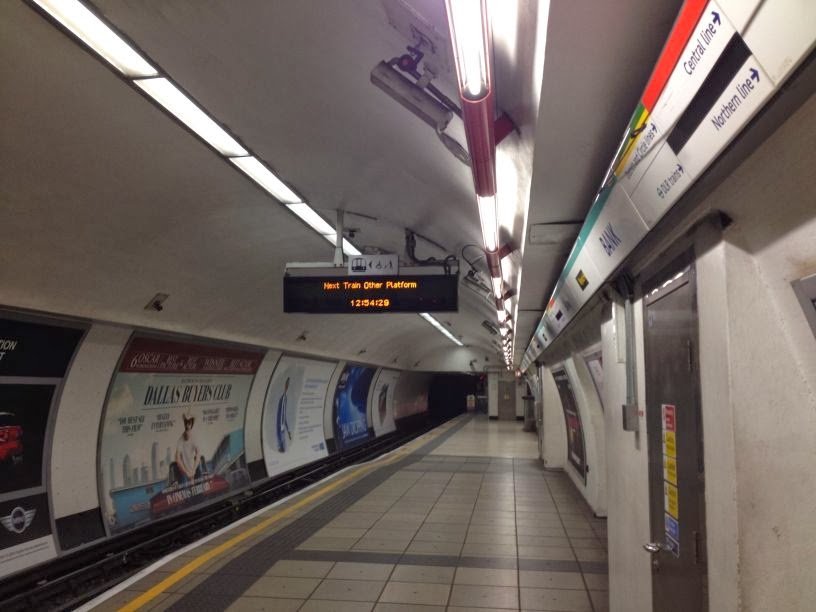My daily Tube route is a fairly basic half loop around the Circle Line from Paddington to Tower Hill, but every once in a while I also mix this up with a quick dive down the Bakerloo Line to Embankment and then a cut across to Tower Hill on the District Line. Variety, as they say, is the spice!
Not even the tourists I seem to bump into every day could get lost on this line.
Even to the casual observer there’s one of the eleven lines which stands out as a little bit special. This is the Waterloo & City line, which with its grand total of two stations is never going to feature on many a tourist’s route map. Never having travelled on this, dare I say, whimsical little line, I thought this would make an ideal episode of Things You See At Lunch.
Those familiar with the Tube layout will quickly realise that from my terminus of Tower Hill I only needed to make the one stop west on the District Line to Monument and then walk through the miles of tunnels to Bank and jump on the targeted turquoise line.
The first job was simply done, delayed only by a sluggish Tube worker who stumbled down the stairs at snail’s pace meaning I missed one tube and had to wait at least all of three minutes for the next one. The route through Monument to the Bank side of this joined station is torturous to say the least. You go down two escalators (stand on the right) along two corridors (walking first on the right then the left) and back up two escalators before taking the “branch” corridor to the Waterloo & City platforms.
Going down the first escalator.
The rather space-age looking corridor to the Waterloo & City Line.
As you would expect, there are still two platforms because although there’s only two stations, it’s not a shuttle service. Taking advice from the sign which told me the next train was coming into the other platform I crossed over and had but to wait a minute or two for the arrival of said train.
Go to the other platform.
Alright I will. The train that took me from Bank to Waterloo.
The trains running on the W&C are only four carriages long, much shorter than the ones serving the other lines, but the actual design of the carriages are the same. I was never the less delighted to see that the bars in the carriage were done in matching turquoise, which is something I think is a must. I’ve still never forgiven the “black” Northern Line for using yellow bars!
Turquoise bars and empty carriages.
I’m guessing the line might be chocca with commuters during rush hours, but on a quiet Tuesday lunchtime there was only a smattering of others in my carriage and the only people watching I could do was the pink boots of the woman opposite.
The view down the tunnel to the depot.
The journey took exactly 4 minutes 14 seconds so before I knew it were had dived 7 metres under the Thames and emerged at Waterloo. At the end of the platform you could take a peek down the rest of the tunnel to the line’s terminus where the trains undergo their repairs and maintenance. One other difference between this line and all the rest is that it’s all totally “underground” and the rolling stock has to be lifted by cane in and out of the line. All the other lines have some part of their route overground, apart from the Victorian Line but even this has its depot overground.
Waterloo Station Clock.
The foot journey into Waterloo station is much quicker at this end and before you could say “nice station clock” I’d walked from my emerging point by Platform 6 and re-entered the underground system by Platform 18.
The platforms at Waterloo work differently to the ones at Bank though, basically from what I can make out, you have an arrivals platform and a departures platform, unlike Bank where you have two platforms both welcoming and dispatching trains.
The "exit" platform at Waterloo.
The train that took me from Waterloo to Bank.
Deciding I didn’t want to traipse back through the corridors and escalators back to Monument I exited through the barriers and took the spectacular 140 metres worth of Travelator back to Bank proper. I then left the station to make my way back overground and promptly got caught in a cloud burst and arrived back at the office dripping!
Travelling the Travelator.
Want some more facts about the Waterloo & City?
- The line opened in 1898 but was the last line to be incorporated into London Underground from British Rail in 1994
- Bank station was originally called City, hence the name of the line.
- The length of the line is 2.37 kms
- The line has the nickname “The Drain”
Will that do? No? Then do your own reading!
Links
























